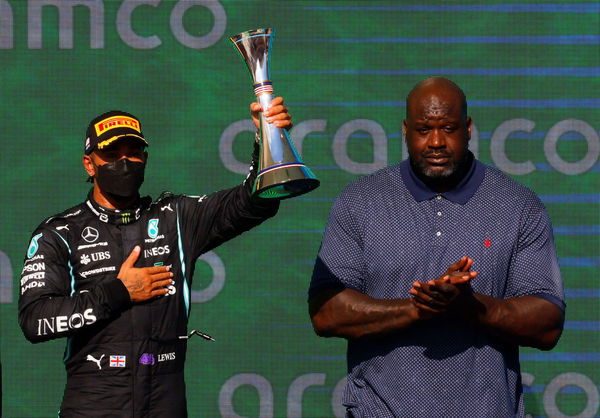
via Reuters
Formula One F1 – United States Grand Prix – Circuit of the Americas, Austin, Texas, U.S. – October 24, 2021 Mercedes’ Lewis Hamilton celebrates on the podium with the runners up trophy, alongside American former professional basketball player Shaquille O’Neal REUTERS/Brian Snyder
F1 is a sport that is not for the faint-hearted. The adrenaline rush, the speed, and the competitive urge to be the best on the track is a ‘turn-on’ for many. It is also growing at a tremendous speed with both – the younger and the older generations getting hooked. However, much of the credit goes to Liberty Media, who introduced a plan to grow the sport’s fan base in the US.
The reigning World Champion Max Verstappen recently accused DTS of ‘dramatizing’ F1. Little did the Dutch driver know that is what they were hoping for in the first place. Hard Knocks and Ultimate Fighter have used the same trick as well.
ADVERTISEMENT
Article continues below this ad
Since DTS first aired, Formula 1 has enjoyed a 40% increase in the US viewership, contributed to 7 out of the 10 most viewed races of all time, and also holds the record of hosting the most people in a single race when 400,000 people came to watch the US Grand Prix 2021 in Austin.
The result of it? F1’s valuation shot up from $8B to $13B in just 3 years. A remarkable rise of 63%. The Hollywood numbers don’t end there; Formula 1 gained a whopping 73 million fans globally last year. The sport became more popular with women as female viewership almost doubled from 10% to 18.3% in just 4 years.
READ MORE: How Does the Netflix Drive to Survive Crew Work With F1 Teams?
DTS focused on the human side of the drivers and initially, the two biggest constructors – Ferrari and Mercedes refused to participate in it. However, instead of promoting Formula 1 as a sport, Liberty Media positioned it as a content company.
The rivalry between your teammate beating you, your rival outpacing you and your own team throwing you under the bus was all the content people needed. Netflix gambled on drama and it paid huge dividends.
How Drive To Survive revolutionized F1
Formula One has always been a popular sport in the European continent. Although they failed to attract fans from North America and popularize the sport across the pond. When Liberty Media took over the realms of Formula 1, they targeted the U.S. to generate interest and increase their viewership.
DTS took storytelling abilities to a completely new level and magnified the tension and conflicts inside the grid. They targeted two dynamics; Tension between teams and tension between teammates. Diving deeper into rivalry helped them generate spicy content, which is what the audience feasts upon.
ADVERTISEMENT
Article continues below this ad
Trending
Max Verstappen and Valtteri Bottas Fall Prey to Theft Right Before Ayrton Senna Tribute

How Did Lando Norris’ Father Accumulate $205,000,000 Worth Fortune?

F1 Imola GP 2024: Who Are the Commentators for the Race?

Who Is Bryan Bozzi: Charles Leclerc’s New Race Engineer at Ferrari

How Many Languages Does Ferrari’s Wonder Boy Charles Leclerc Speak?

View this post on Instagram
The DTS series wasn’t just beneficial to Formula One, it also helped the constructors. Teams are generating interest from potential investors, which was very difficult to attract in the past. The most mind-boggling fact of it all is that Netflix pays Formula 1 a licensing fee to cover exclusive content for their documentary.
ADVERTISEMENT
Article continues below this ad
WATCH THIS STORY: Daniel Ricciardo Pushed Aside as Lewis Hamilton Takes The Spotlight With Avid F1 Fan
It’s mental how Formula 1 has risen like a phoenix from its ashes. The growth of Formula 1 is an incredible story and the new owners have taken steps in the right direction to promote the sport. If last year’s finale at Abu Dhabi GP is anything to go by, we’re in for some classic battles in the future. May the show keep going on forever.
Edited by
Ranvijay Singh

